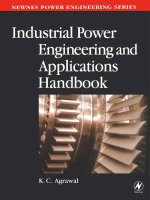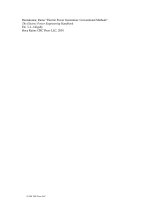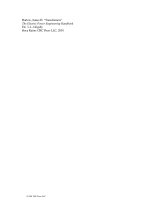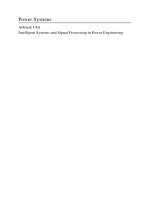power system (the electric power engineering)
Bạn đang xem bản rút gọn của tài liệu. Xem và tải ngay bản đầy đủ của tài liệu tại đây (8.19 MB, 453 trang )
Electric Power Engineering Handbook
Second Edition
Edited by
Leonard L. Grigsby
Electric Power Generation, Transmission, and Distribution
Edited by Leonard L. Grigsby
Electric Power Transformer Engineering, Second Edition
Edited by
James H. Harlow
Electric Power Substations Engineering, Second Edition
Edited by
John D. McDonald
Power Systems
Edited by Leonard L. Grigsby
Power System Stability and Control
Edited by Leonard L. Grigsby
ß 2006 by Taylor & Francis Group, LLC.
The Electrical Engineering Handbook Series
Series Editor
Richard C. Dorf
University of California, Davis
Titles Included in the Series
The Handbook of Ad Hoc Wireless Networks, Mohammad Ilyas
The Biomedical Engineering Handbook, Third Edition, Joseph D. Bronzino
The Circuits and Filters Handbook, Second Edition, Wai-Kai Chen
The Communications Handbook, Second Edition, Jerry Gibson
The Computer Engineering Handbook, Second Edtion, Vojin G. Oklobdzija
The Control Handbook, William S. Levine
The CRC Handbook of Engineering Tables, Richard C. Dorf
The Digital Avionics Handbook, Second Edition Cary R. Spitzer
The Digital Signal Processing Handbook, Vijay K. Madisetti and Douglas Williams
The Electrical Engineering Handbook, Third Edition, Richard C. Dorf
The Electric Power Engineering Handbook, Second Edition, Leonard L. Grigsby
The Electronics Handbook, Second Edition, Jerry C. Whitaker
The Engineering Handbook, Third Edition, Richard C. Dorf
The Handbook of Formulas and Tables for Signal Processing, Alexander D. Poularikas
The Handbook of Nanoscience, Engineering, and Technology, Second Edition,
William A. Goddard, III, Donald W. Brenner, Sergey E. Lyshevski, and Gerald J. Iafrate
The Handbook of Optical Communication Networks, Mohammad Ilyas and
Hussein T. Mouftah
The Industrial Electronics Handbook, J. David Irwin
The Measurement, Instrumentation, and Sensors Handbook, John G. Webster
The Mechanical Systems Design Handbook, Osita D.I. Nwokah and Yidirim Hurmuzlu
The Mechatronics Handbook, Second Edition, Robert H. Bishop
The Mobile Communications Handbook, Second Edition, Jerry D. Gibson
The Ocean Engineering Handbook, Ferial El-Hawary
The RF and Microwave Handbook, Second Edition, Mike Golio
The Technology Management Handbook, Richard C. Dorf
The Transforms and Applications Handbook, Second Edition, Alexander D. Poularikas
The VLSI Handbook, Second Edition, Wai-Kai Chen
ß 2006 by Taylor & Francis Group, LLC.
Electric Power Engineering Handbook
Second Edition
POWER SYSTEMS
Edited by
Leonard L. Grigsby
ß 2006 by Taylor & Francis Group, LLC.
CRC Press
Taylor & Francis Group
6000 Broken Sound Parkway NW, Suite 300
Boca Raton, FL 33487-2742
© 2007 by Taylor & Francis Group, LLC
CRC Press is an imprint of Taylor & Francis Group, an Informa business
No claim to original U.S. Government works
Printed in the United States of America on acid-free paper
10 9 8 7 6 5 4 3 2 1
International Standard Book Number-10: 0-8493-9288-8 (Hardcover)
International Standard Book Number-13: 978-0-8493-9288-7 (Hardcover)
This book contains information obtained from authentic and highly regarded sources. Reprinted material is quoted
with permission, and sources are indicated. A wide variety of references are listed. Reasonable efforts have been made to
publish reliable data and information, but the author and the publisher cannot assume responsibility for the validity of
all materials or for the consequences of their use.
No part of this book may be reprinted, reproduced, transmitted, or utilized in any form by any electronic, mechanical, or
other means, now known or hereafter invented, including photocopying, microfilming, and recording, or in any informa-
tion storage or retrieval system, without written permission from the publishers.
For permission to photocopy or use material electronically from this work, please access www.copyright.com (http://
www.copyright.com/) or contact the Copyright Clearance Center, Inc. (CCC) 222 Rosewood Drive, Danvers, MA 01923,
978-750-8400. CCC is a not-for-profit organization that provides licenses and registration for a variety of users. For orga-
nizations that have been granted a photocopy license by the CCC, a separate system of payment has been arranged.
Trademark Notice: Product or corporate names may be trademarks or registered trademarks, and are used only for
identification and explanation without intent to infringe.
Library of Congress Cataloging-in-Publication Data
Power systems / editor, Leonard Lee Grigsby.
p. cm.
Includes bibliographical references and index.
ISBN-13: 978-0-8493-9288-7 (alk. paper)
ISBN-10: 0-8493-9288-8 (alk. paper)
1. Electric power systems. I. Grigsby, Leonard L.
TK1001.P65 2007
621.31 dc22 2007005730
Visit the Taylor & Francis Web site at
and the CRC Press Web site at
ß 2006 by Taylor & Francis Group, LLC.
Table of Contents
Preface
Editor
Contributors
I Power System Analysis and Simulation
1 The Per-Unit System
Charles A. Gross
2 Symmetrical Components for Power System Analysis
Tim A. Haskew
3 Power Flow Analysis
Leonard L. Grigsby and Andrew P. Hanson
4 Fault Analysis in Power Systems
Charles A. Gross
5 Computational Methods for Electric Power Systems
Mariesa L. Crow
II Power System Transients
6 Characteristics of Lightning Strokes
Francisco de la Rosa
7 Overvoltages Caused by Direct Lightning Strokes
Pritindra Chowdhuri
8 Overvoltages Caused by Indirect Lightning Strokes
Pritindra Chowdhuri
9 Switching Surges
Stephen R. Lambert
10 Very Fast Transients
Juan A. Martinez-Velasco
11 Transient-Voltage Response of Coils and Windings
Robert C. Degeneff
12 Transmission System Transients—Grounding
William A. Chisholm
ß 2006 by Taylor & Francis Group, LLC.
13 Surge Arresters
Thomas E. McDermott
14 Insulation Coordination
Stephen R. Lambert
III Power System Planning (Reliability)
15 Planning
Gerald B. Sheble
´
16 Short-Term Load and Price Forecasting with Artificial Neural Networks
Alireza Khotanzad
17 Transmission Plan Evaluation—Assessment of System Reliability
N. Dag Reppen and James W. Feltes
18 Power System Planning
Hyde M. Merrill
19 Power System Reliability
Richard E. Brown
20 Probabilistic Methods for Planning and Operational Analysis
Gerald T. Heydt and Peter W. Sauer
IV Power Electronics
21 Power Semiconductor Devices
Kaushik Rajashekara
22 Uncontrolled and Controlled Rectifiers
Mahesh M. Swamy
23 Inverters
Michael Giesselmann
24 Active Filters for Power Conditioning
Hirofumi Akagi
25 FACTS Controllers
Luis Mora
´
n, Juan Dixon, M. Jose
´
Espinoza, and Jose
´
Rodrı
´
guez
ß 2006 by Taylor & Francis Group, LLC.
Preface
The generation, delivery, and utilization of electric power and energy remain one of the most challen-
ging and exciting fields of electrical engineering. The astounding technological developments of our age
are highly dependent upon a safe, reliable, and economic supply of electric power. The objective of
Electric Power Engineering Handbook, 2nd Edition is to provide a contemporary overview of this far-
reaching field as well as to be a useful guide and educational resource for its study. It is intended to
define electric power engineering by bringing together the core of knowledge from all of the many topics
encompassed by the field. The chapters are written primarily for the electric power engineering
professional who is seeking factual information, and secondarily for the professional from other
engineering disciplines who wants an overview of the entire field or specific information on one aspect
of it.
The handbook is published in five volumes. Each is organized into topical sections and chapters in an
attempt to provide comprehensive coverage of the generation, transformation, transmission, distribu-
tion, and utilization of electric power and energy as well as the modeling, analysis, planning, design,
monitoring, and control of electric power systems. The individual chapters are different from most
technical publications. They are not journal-type chapters nor are they textbook in nature. They are
intended to be tutorials or overviews providing ready access to needed information while at the same
time providing sufficient references to more in-depth coverage of the topic. This work is a member of
the Electrical Engineering Handbook Series published by CRC Press. Since its inception in 1993, this
series has been dedicated to the concept that when readers refer to a handbook on a particular topic they
should be able to find what they need to know about the subject most of the time. This has indeed been
the goal of this handbook.
This volume of the handbook is devoted to the subjects of power system analysis and simulation,
power system transients, power system planning, and power electronics. If your particular topic of
interest is not included in this list, please refer to the list of companion volumes seen at the beginning of
this book.
In reading the individual chapters of this handbook, I have been most favorably impressed by how
well the authors have accomplished the goals that were set. Their contributions are, of course, most key
to the success of the work. I gratefully acknowledge their outstanding effor ts. Likewise, the expertise and
dedication of the editorial board and section editors have been critical in making this handbook
possible. To all of them I express my profound thanks. I also wish to thank the personnel at Taylor &
Francis who have been involved in the production of this book, with a special word of thanks to Nora
Konopka, Allison Shatkin, and Jessica Vakili. Their patience and perseverance have made this task most
pleasant.
Leo Grigsby
Editor-in-Chief
ß 2006 by Taylor & Francis Group, LLC.
ß 2006 by Taylor & Francis Group, LLC.
Editor
Leonard L. (‘‘Leo’’) Grigsby received his BS and MS in electrical engineering from Texas Tech University
and his PhD from Oklahoma State University. He has taught electrical engineering at Texas Tech,
Oklahoma State University, and Virginia Polytechnic Institute and University. He has been at Auburn
University since 1984 first as the Georgia power distinguished professor, later as the Alabama power
distinguished professor, and currently as professor emeritus of electrical engineering. He also spent nine
months during 1990 at the University of Tokyo as the Tokyo Electric Power Company endowed chair of
electrical engineering. His teaching interests are in network analysis, control systems, and power
engineering.
During his teaching career, Professor Grigsby has received 13 awards for teaching excellence. These
include his selection for the university-wide William E. Wine Award for Teaching Excellence at Virginia
Polytechnic Institute and University in 1980, his selection for the ASEE AT&T Award for Teaching
Excellence in 1986, the 1988 Edison Electric Institute Power Engineering Educator Award, the
1990–1991 Distinguished Graduate Lectureship at Auburn University, the 1995 IEEE Region 3 Joseph
M. Beidenbach Outstanding Engineering Educator Award, the 1996 Birdsong Superior Teaching Award at
Auburn University, and the IEEE Power Engineering Society Outstanding Power Engineering Educator
Award in 2003.
Professor Grigsby is a fellow of the Institute of Electrical and Electronics Engineers (IEEE). During
1998–1999 he was a member of the board of directors of IEEE as director of Division VII for power and
energy. He has served the Institute in 30 different offices at the chapter, section, regional, and
international levels. For this service, he has received seven distinguished service awards, the IEEE
Centennial Medal in 1984, the Power Engineering Society Meritorious Service Award in 1994, and the
IEEE Millennium Medal in 2000.
During his academic career, Professor Grigsby has conducted research in a variety of projects related
to the application of network and control theory to modeling, simulation, optimization, and control of
electric power systems. He has been the major advisor for 35 MS and 21 PhD graduates. With his
students and colleagues, he has published over 120 technical papers and a textbook on introductory
network theory. He is currently the series editor for the Electrical Engineering Handbook Series
published by CRC Press. In 1993 he was inducted into the Electrical Engineering Academy at Texas
Tech University for distinguished contributions to electrical engineering.
ß 2006 by Taylor & Francis Group, LLC.
ß 2006 by Taylor & Francis Group, LLC.
Contributors
Hirofumi Akagi
Tokyo Institute of Technology
Tokyo, Japan
Richard E. Brown
InfraSource Technology
Raleigh, North Carolina
William A. Chisholm
Kinectrics=UQAC
Toronto, Ontario, Canada
Pritindra Chowdhuri
Tennessee Technological University
Cookeville, Tennessee
Mariesa L. Crow
University of Missouri–Rolla
Rolla, Missouri
Robert C. Degeneff
Rensselaer Polytechnic Institute
Troy, New York
Juan Dixon
Pontificia Universidad Cato
´
lica de Chile
Santiago, Chile
M. Jose
´
Espinoza
Universidad de Concepcio
´
n
Concepcio
´
n, Chile
James W. Feltes
Power Technologies
Schenectady, New York
Michael Giesselmann
Texas Tech University
Lubbock, Texas
Charles A. Gross
Auburn University
Auburn, Alabama
Andrew P. Hanson
PowerComm Engineering
Raleigh, North Carolina
Tim A. Haskew
University of Alabama
Tuscaloosa, Alabama
Gerald T. Heydt
Arizona State University
Tempe, Arizona
Alireza Khotanzad
Southern Methodist University
Dallas, Texas
Stephen R. Lambert
Shawnee Power Consulting, LLC
Williamsburg, Virginia
Juan A. Martinez-Velasco
Universitat Politecnica de Catalunya
Barcelona, Spain
Thomas E. McDermott
EnerNex Corporation
Pittsburgh, Pennsylvania
ß 2006 by Taylor & Francis Group, LLC.
Hyde M. Merrill
Merrill Energy, LLC
Schenectady, New York
Luis Mora
´
n
Universidad de Concepcio
´
n
Concepcio
´
n, Chile
Mark Nelms
Auburn University
Auburn, Alabama
Kaushik Rajashekara
Delphi Automotive Systems
Kokomo, Indiana
N. Dag Reppen
Niskayuna Power Consultants, LLC
Schenectady, New York
Jose
´
Rodrı
´
guez
Universidad Te
´
chnica Federico Santa Marı
´
a
Valparaı
´
so, Chile
Francisco de la Rosa
Distribution Control Systems, Inc.
Hazelwood, Missouri
Peter W. Sauer
University of Illinois at Urbana-Champaign
Urbana, Illinois
Gerald B. Sheble
´
Portland State University
Portland, Oregon
Mahesh M. Swamy
Yaskawa Electric America
Waukegan, Illinois
ß 2006 by Taylor & Francis Group, LLC.
I
Power System
Analysis and
Simulation
Leonard L. Grigsby
Auburn University
Andrew P. Hanson
PowerComm Engineering
1 The Per-Unit System Charles A. Gross 1 -1
Impact on Transformers
.
Per-Unit Scaling Extended to Three-Phase Systems
.
Per-Unit Scaling
Extended to a General Three-Phase System
2 Sy mmetr ical Components for Power System Analysis Tim A. Haskew 2 -1
Fundamental Definitions
.
Reduction to the Balanced Case
.
Sequence Network Representation
in Per-Unit
3 Power Flow Analysis Leonard L. Gr ig sby and Andrew P. Hanson 3 -1
Introduction
.
Power Flow Problem
.
Formulation of Bus Admittance Matrix
.
Formulation of
Power Flow Equations
.
P –V Buses
.
Bus Classifications
.
Generalized Power Flow Development
.
Solution Methods
.
Component Power Flows
4 Fault Analysis in Power Systems Charles A. Gross 4 -1
Simplifications in the System Model
.
The Four Basic Fault Ty pes
.
An Example Fault Study
.
Further Considerations
.
Summar y
.
Defining Terms
5 Computational Methods for Electr ic Power Systems Mariesa L. Crow 5 -1
Power Flow
.
Optimal Power Flow
.
State Estimation
ß 2006 by Taylor & Francis Group, LLC.
ß 2006 by Taylor & Francis Group, LLC.
1
The Per-Unit System
Charles A. Gross
Auburn University
1.1 Impact on Transformers 1-4
1.2 Per-Unit Scaling Extended to Three-Phase Systems 1-7
1.3 Per-Unit Scaling Extended to a General
Three-Phase System 1-11
In many engineering situations, it is useful to scale or normalize quantities. This is commonly done in
power system analysis, and the standard method used is referred to as the per-unit system. Historically,
this was done to simplify numerical calculations that were made by hand. Although this advantage has
been eliminated by using the computer, other advantages remain:
.
Device parameters tend to fall into a relatively narrow range, making erroneous values
conspicuous.
.
The method is defined in order to eliminate ideal transformers as circuit components.
.
The voltage throughout the power system is normally close to unity.
Some disadvantages are that component equivalent circuits are somewhat more abstract. Sometimes
phase shifts that are clearly present in the unscaled circuit are eliminated in the per-unit circuit.
It is necessary for power system engineers to become familiar with the system because of its wide
industrial acceptance and use and also to take advantage of its analytical simplifications. This discussion
is limited to traditional AC analysis, with voltages and currents represented as complex phasor values.
Per-unit is sometimes extended to transient analysis and may include quantities other than voltage,
power, current, and impedance.
The basic per-unit scaling equation is
Per-unit value ¼
actual value
base value
: (1:1)
The base value always has the same units as the actual value, forcing the per-unit value to be
dimensionless. Also, the base value is always a real number, whereas the actual value may be complex.
Representing a complex value in polar form, the angle of the per-unit value is the same as that of the
actual value.
Consider complex power
S ¼ VI* (1:2)
or
Sffu ¼ VffaIffÀb
where V ¼phasor voltage, in volts; I ¼phasor current, in amperes.
ß 2006 by Taylor & Francis Group, LLC.
Suppose we ar bitrarily pick a value S
base
, a real number wi th the units of volt-amperes. Div iding
throug h by S
base
,
Sffu
S
base
¼
Vffa I ffÀb
S
base
:
We fur ther define
V
base
I
base
¼ S
base
: (1: 3)
Either V
base
or I
base
may be selected arbitrarily, but not both. Substituting Eq. (1.3) into Eq. (1.2), we obtain
Sffu
S
base
¼
Vffa IffÀbðÞ
V
base
I
base
S
pu
ffu ¼
Vffa
V
base
IffÀb
I
base
S
pu
¼ V
pu
ffa I
pu
ffÀb
ÀÁ
S
pu
¼ V
pu
I
pu
* (1:4)
The subscript pu indicates per-unit values. Note that the form of Eq. (1.4) is identical to Eq. (1.2).
This was not inevitable, but resulted from our decision to relate V
base
I
base
and S
base
through Eq. (1.3).
If we select Z
base
by
Z
base
¼
V
base
I
base
¼
V
2
base
S
base
: (1:5)
Convert Ohm’s law:
Z ¼
V
I
(1:6)
into per-unit by dividing by Z
base
.
Z
Z
base
¼
V=I
Z
base
Z
pu
¼
V=V
base
I=I
base
¼
V
pu
I
pu
:
Observe that
Z
pu
¼
Z
Z
base
¼
R þ jX
Z
base
¼
R
Z
base
þ j
X
Z
base
Z
pu
¼ R
pu
þ jX
pu
(1:7)
Thus, separate bases for R and X are not necessary:
Z
base
¼ R
base
¼ X
base
By the same logic,
S
base
¼ P
base
¼ Q
base
ß 2006 by Taylor & Francis Group, LLC.
Example 1.1
(a) Solve for Z, I, and S at Port ab in Fig. 1.1a.
(b) Repeat (a) in per-unit on bases of V
base
¼100 V and S
base
¼1000 V. Draw the corresponding per-
unit circuit.
Solution
(a) Z
ab
¼8 þ j12 À j6 ¼8 þ j6 ¼10 ff36.98V
I ¼
V
ab
Z
ab
¼
100ff0
10ff36:9
¼ 10ffÀ36:9
amperes
S ¼ VI* ¼ 100ff0
ðÞ10ffÀ36:9
ðÞ*
¼ 1000ff36:9
¼ 800 þ j600 VA
P ¼ 800 W Q ¼ 600 var
(b) On bases V
base
and S
base
¼1000 VA:
Z
base
¼
V
2
base
S
base
¼
100ðÞ
2
1000
¼ 10 V
I
base
¼
S
base
V
base
¼
1000
100
¼ 10 A
V
pu
¼
100ff0
100
¼ 1ff0
pu
Z
pu
¼
8 þ j12 À j6
10
¼ 0:8 þ j0:6pu
¼ 1:0ff36:9
pu
I
pu
¼
V
pu
Z
pu
¼
1ff0
1ff36:9
¼ 1ffÀ36:9
pu
S
pu
¼ V
pu
I
pu
* ¼ 1ff0
ðÞ1ffÀ36:9
ðÞ* ¼ 1ff36:9
pu
¼ 0:8 þ j0:6pu
Converting results in (b) to SI units:
I ¼ I
pu
ÀÁ
I
base
¼ 1ffÀ36:9
ðÞ10ðÞ¼10ffÀ36:9
A
Z ¼ Z
pu
ÀÁ
Z
base
¼ 0:8 þ j0:6ðÞ10ðÞ¼8 þ j6 V
S ¼ S
pu
ÀÁ
S
base
¼ 0:8 þ j0:6ðÞ1000ðÞ¼800 þ j600 W, var
The results of (a) and (b) are identical.
a
b(a)
+
volts
I
−
8Ω
j12Ω
−j6Ω
100∠0
°
(b)
b
+
pu
I
−
0.8 pu
j1.2 pu
−j0.6 pu
1∠0
°
FIGURE 1.1 (a) Circuit with elements in SI units. (b) Circuit with elements in per-unit.
ß 2006 by Taylor & Francis Group, LLC.
For power system applications, base values for S
base
and V
base
are arbitrarily selected. Actually, in
practice, values are selected that force results into certain ranges. Thus, for V
base
, a value is chosen such
that the normal system operating voltage is close to unity. Popular power bases used are 1, 10, 100, and
1000 MVA, depending on system size.
1.1 Impact on Transformers
Tounderstandthe impactofpuscalingon transformer,considerthethree-windingidealdevice(see Fig.1.2).
For sinusoidal steady-state performance:
V
1
¼
N
1
N
2
V
2
(1:8a)
V
2
¼
N
2
N
3
V
3
(1:8b)
V
3
¼
N
3
N
1
V
1
(1:8c)
and
N
1
I
1
þ N
2
I
2
þ N
3
I
3
¼ 0(1:9)
Consider the total input complex power S.
S ¼ V
1
I
1
* þ V
2
I
2
* þ V
3
I
3
*
¼ V
1
I
1
* þ
N
2
N
1
V
1
I
2
* þ
N
3
N
1
V
1
I
3
*
¼
V
1
N
1
N
1
I
1
þ N
2
I
2
þ N
3
I
3
½*
¼ 0
(1:10)
The interpretation to be made here is that the ideal transformer can neither absorb real nor reactive
power. An example should clarify these properties.
+
+
V
2
V
1
N
1
: N
2
: N
3
I
2
I
1
I
3
V
3
−
+
ideal
−
−
FIGURE 1.2 The three-winding ideal transformer.
ß 2006 by Taylor & Francis Group, LLC.
Arbitrarily select two base values V
1base
and S
1base
. Require base values for windings 2 and 3 to be:
V
2base
¼
N
2
N
1
V
1base
(1:11a)
V
3base
¼
N
3
N
1
V
1base
(1:11b)
and
S
1base
¼ S
2base
¼ S
3base
¼ S
base
(1:12)
By definition,
I
1base
¼
S
base
V
1base
(1:13a)
I
2base
¼
S
base
V
2base
(1:13b)
I
3base
¼
S
base
V
3base
(1:13c)
It follows that
I
2base
¼
N
1
N
2
I
1base
(1:14a)
I
3base
¼
N
1
N
3
I
1base
(1:14b)
Recall that a per-unit value is the actual value divided by its appropriate base. Therefore:
V
1
V
1base
¼
N
1
=N
2
ðÞV
2
V
1base
(1:15a)
and
V
1
V
1base
¼
N
1
=N
2
ðÞV
2
N
1
=N
2
ðÞV
2base
(1:15b)
or
V
1pu
¼ V
2pu
(1:15c)
indicates per-unit values. Similarly,
V
1
V
1base
¼
N
1
=N
3
ðÞV
3
N
1
=N
3
ðÞV
3base
(1:16a)
or
V
1pu
¼ V
3pu
(1:16b)
ß 2006 by Taylor & Francis Group, LLC.
Summarizing:
V
1pu
¼ V
2pu
¼ V
3pu
(1: 17)
Div ide Eq. (1.9) by N
1
I
1
þ
N
2
N
1
I
2
þ
N
3
N
1
I
3
¼ 0
Now div ide throug h by I
1 base
I
1
I
1base
þ
N
2
=N
1
ðÞI
2
I
1base
þ
N
3
= N
1
ðÞI
3
I
1base
¼ 0
I
1
I
1base
þ
N
2
= N
1
ðÞI
2
N
2
=N
1
ðÞI
2base
þ
N
3
=N
1
ðÞI
3
N
3
=N
1
ðÞI
3base
¼ 0
Simplify ing to
I
1pu
þ I
2pu
þ I
3pu
¼ 0(1: 18)
Equations (1.17) and (1.18) suggest the basic scaled equivalent circuit, shown in Fig . 1.3. It is
cumbersome to carr y the pu in the subscript past this point: no confusion should result, since all
quantities w ill show units, including pu.
Example 1.2
The 3-w inding sing le-phase transformer of Fig . 1.1 is rated at 13.8 kV= 138kV =4.157 kV and 50 MVA =40
MVA =10 MVA. Terminations are as follow ings:
13.8 kV w inding: 13.8 kV Source
138 kV w inding: 35 MVA load, pf ¼ 0.866 lagging
4.157 kV w inding: 5 MVA load, pf ¼ 0.866 leading
Using S
base
¼ 10 MVA, and voltage ratings as bases,
(a) Draw the pu equivalent circuit.
(b) Solve for the primar y current, power, and power, and power factor.
Solution
(a) See Fig . 1.4.
(b,c) S
2
¼
35
10
¼ 3:5pu S
2
¼ 3:5ffþ30
pu
S
3
¼
5
10
¼ 0:5pu S
3
¼ 0:5ffÀ30
pu
V
1
¼
13:8
13:8
¼ 1:0pu V
1
¼ V
2
¼ V
3
¼ 1:0ff0
pu
I
2
¼
S
2
V
2
* ¼ 3:5ffÀ30
pu
I
3
¼
S
3
V
3
* ¼ 0:5ffþ30
pu
I
1
I
2
I
3
V
1
V
3
+ V
2
1
2
3
+
+
−
−
−
FIGURE 1.3 Single-phase ideal transformer.
ß 2006 by Taylor & Francis Group, LLC.
All values in Per-Unit Equivalent Circuit:
I
1
¼ I
2
þ I
3
¼ 3:5ffÀ30
þ 0:5ffþ30
¼ 3:464 À j1:5 ¼ 3:775ffÀ23:4
pu
S
1
¼ V
1
I
1
* ¼ 3:775ffþ23:4
pu
S
1
¼ 3:775 10ðÞ¼37:75 MVA; pf ¼ 0:9177 lagging
I
1
¼ 3:775
10
0:0138
¼ 2736 A
1.2 Per-Unit Scaling Extended to Three-Phase Systems
The extension to three-phase systems has been complicated to some extent by the use of traditional
terminology and jargon, and a desire to normalize phase-to-phase and phase-to-neutral voltage simul-
taneously. The problem with this practice is that it renders Kirchhoff’s voltage and current laws invalid in
some circuits. Consider the general three-phase situation in Fig. 1.5, with all quantities in SI units.
Define the complex operator:
a ¼ 1ff120
The system is said to be balanced, with sequence abc, if:
V
bn
¼ a
2
V
an
V
cn
¼ aV
an
and
I
b
¼ a
2
I
a
I
c
¼ aI
a
ÀI
n
¼ I
a
þ I
b
þ I
c
¼ 0
Likewise:
V
ab
¼ V
an
À V
bn
V
bc
¼ V
bn
À V
cn
¼ a
2
V
ab
V
ca
¼ V
cn
À V
an
¼ aV
ab
I
1
I
2
= 3.5∠− 30°
I
3
= 0.5∠+ 30°
V
1
V
2
V
3
1
2
3
1∠0°
+
+
+
+
−−−−
FIGURE 1.4 Per-unit circuit.
General
Source
General
Load
a
I
a
I
b
I
c
V
an
V
bn
V
cn
I
n
b
+
+
−−
c
n
FIGURE 1.5 General three-phase system.
ß 2006 by Taylor & Francis Group, LLC.
If the load consists of wye-connected impedance:
Z
y
¼
V
an
I
a
¼
V
bn
I
b
¼
V
cn
I
c
The equivalent delta element is:
Z
D
¼ 3Z
Y
To convert to per-unit, define the following bases:
S
3fbase
¼The three-phase apparent base at a specific location in a three-phase system, in VA.
V
Lbase
¼The line (phase-to-phase) rms voltage base at a specific location in a three-phase system, in V.
From the above, define:
S
base
¼ S
3f
base
=3(1:19)
V
base
¼ V
L
base
=
ffiffiffi
3
p
(1:20)
It follows that:
I
base
¼ S
base
=V
base
(1:21)
Z
base
¼ V
base
=I
base
(1:22)
An example will be useful.
Example 1.3
Consider a balanced three-phase 60 MVA 0.8 pf lagging load, sequence abc operating from a 13.8 kV
(line voltage) bus. On bases of S
3fbase
¼100 MVA and V
Lbase
¼13.8 kV:
(a) Determine all bases.
(b) Determine all voltages, currents, and impedances, in SI units and per-unit.
Solution
(a) S
base
¼
S
3fbase
3
¼
100
3
¼ 33:33 MVA
V
base
¼
V
Lbase
ffiffiffi
3
p
¼
13:8
ffiffiffi
3
p
¼ 7:967 kV
I
base
¼
S
base
V
base
¼ 4:184 kA
Z
base
¼
V
base
I
base
¼ 1:904 V
(b) V
an
¼ 7:967ff0
kV 1:000ff0
puðÞ
V
bn
¼ 7:967ffÀ120
kV 1:000ffÀ120
puðÞ
V
cn
¼ 7:967ffþ120
kV 1:000ffþ120
pu
ðÞ
S
a
¼ S
b
¼ S
c
¼
S
3f
3
¼
60
3
¼ 20 MVAð0:60 puÞ
S
a
¼ S
b
¼ S
c
¼ 16 þ j12 MVA 0:48 þ j0:36 puðÞ
I
a
¼
S
a
V
an
¼ 2:510ffÀ36:9
kA 0:6000ffÀ36:9
puðÞ
ß 2006 by Taylor & Francis Group, LLC.
I
b
¼ 2:510ffÀ156:9
kA 0:6000ffÀ156:9
pu
ðÞ
I
c
¼ 2:510ff83:1
kA 0:6000ff83:1
puðÞ
Z
Y
¼
V
an
I
a
¼ 3:174ffþ36:9
¼ 2:539 þ j1:904 V 1:33 þ j1:000 puðÞ
Z
D
¼ 3Z
Y
¼ 7:618 þ j5:713 V 4 þ j3 puðÞ
V
ab
¼ V
an
À V
bn
¼ 13:8ff30
kV 1:732ff30
puðÞ
V
bc
¼ 13:8ffÀ90
kV 1:732ffÀ90
puðÞ
V
ca
¼ 13:8ff150
kV 1:732ff150
puðÞ
Converting voltages and currents to symmetrical components:
V
0
V
1
V
2
2
6
4
3
7
5
¼
1
3
11 1
1aa
2
1a
2
a
2
6
4
3
7
5
V
an
V
bn
V
cn
2
6
4
3
7
5
¼
0 kV (0 pu)
7:967ff0
kV 1ff0
puðÞ
0kV 0puðÞ
2
6
4
3
7
5
I
0
¼ 0kA0puðÞ
I
1
¼ 2:510ffÀ36:9
kA 0:6ffÀ36:9
puðÞ
I
2
¼ 0kA0pu
ðÞ
Inclusion of transformers demonstrates the advantages of per-unit scaling.
Example 1.4
A3f 240 kV
:15 kV transformer supplies a 13.8 kV 60 MVA pf ¼0.8 lagging load, and is connected
to a 230 kV source on the HV side, as shown in Fig. 1.6.
(a) Determine all base values on both sides for S
3fbase
¼100MVA. At the LV bus, V
Lbase
¼13.8 kV.
(b) Draw the positive sequence circuit in per-unit, modeling the transformer as ideal.
(c) Determine all currents and voltages in SI and per-unit.
Solution
(a) Base values on the LV side are the same as in Example 1.3. The turns ratio may be derived from
the voltage ratings ratios:
N
1
N
2
¼
240=
ffiffiffi
3
p
15=
ffiffiffi
3
p
¼ 16
[ (V
base
)
HV side
¼
N
1
N
2
(V
base
)
LV side
¼ 16:00(7:967) ¼ 127:5kV
(I
base
)
HV side
¼
S
base
(V
base
)
HV side
¼
33:33
0:1275
¼ 261:5A
Load
Low Voltage
(LV) Bus
High Voltage
(HV) Bus
FIGURE 1.6 A three-phase transformer situation.
ß 2006 by Taylor & Francis Group, LLC.
Results are presented in the following chart.
S
3fbase
V
L base
S
base
I
base
V
base
Z
base
Bus MVA kV MVA kA kV ohm
LV 100 13.8 33.33 4.184 7.967 1.904
HV 100 220.8 33.33 0.2615 127.5 487.5
(b) V
LV
¼
7:967ff0
7:967
¼ 1ff0
pu
S
1f
¼
60
3
¼ 20 MVA
S
1f
¼
20
33:33
¼ 0:6pu
The positive sequence circuit is shown as Fig. 1.7.
(c) All values determined in pu are valid on both sides of the transformer! To determine SI values on
the HV side, use HV bases. For example:
V
an
¼ 1ff0
ðÞ
127:5 ¼ 127:5ff0
kV
V
ab
¼ 1:732ff30
ðÞ127:5ðÞ¼220:8ff30
kV
I
a
¼ 0:6ffÀ36:9
ðÞ261:5ðÞ¼156:9ffÀ36:9
A
Example 1.5
Repeat the previous example using a 3f 240 kV:15 kV
D
Solution
All results are the same as before. The reasoning is as follows.
The voltage ratings are interpreted as line (phase-to-phase) values independent of connection (wye or
delta). Therefore the turns ratio remains:
N
1
N
2
¼
240=
ffiffiffi
3
p
15=
ffiffiffi
3
p
¼ 16
As before:
V
an
ðÞ
LV side
¼ 7:967 kV
V
an
ðÞ
HV side
¼ 127:5kV
However, V
an
is no longer in phase on both sides. This is a consequence of the transformer model, and
not due to the scaling procedure. Whether this is important depends on the details of the analysis.
Transformer
+
−
1
∠0°
I = 0.60
∠−36.9°
FIGURE 1.7 Positive sequence circuit.
ß 2006 by Taylor & Francis Group, LLC.









